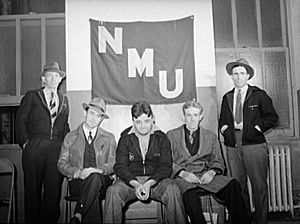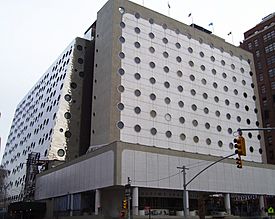National Maritime Union facts for kids
| Merged into | Seafarers International Union of North America (June 3, 2001) |
|---|---|
| Founded | May 1937 |
| Headquarters | New York City, New York |
| Location |
The National Maritime Union (NMU) was an important labor union in the United States. It was started in May 1937 to help workers who sailed on ships. The NMU joined a larger group called the Congress of Industrial Organizations (CIO) in July 1937. After many years, the union joined with the Seafarers International Union of North America in 2001.
Contents
The Start of the Union
The NMU was founded in May 1937 by Joseph Curran and his friends. Joseph Curran was a skilled sailor and a boatswain on a ship called the SS California. He was part of another union, but he wanted to make things better for sailors.
The California Strike
In March 1936, Curran led a strike on the ship California. The crew refused to sail unless they got higher wages and overtime pay. This happened while the ship was docked in California.
The United States Secretary of Labor, Frances Perkins, helped solve the strike. She promised the crew that they would have a meeting to discuss their complaints. She also said the company would not punish them.
When the ship returned, the company did raise wages a little. However, the government and the shipping company called Curran and the strikers "mutineers." Curran and other strike leaders were fired and put on a blacklist, meaning they couldn't easily find work. But Secretary Perkins made sure they were not charged with mutiny.
Forming a New Union
Sailors all along the East Coast went on strike to support the California's crew. Joseph Curran became a leader in this 10-week strike. He then helped create the Seamen's Defense Committee.
In October 1936, Curran called another big strike. This strike involved 50,000 sailors and 300 ships. It lasted four months along the Atlantic and Gulf coasts.
Curran believed it was time to create a new, stronger union. He started signing up members for this new group. Many sailors joined, even delaying their ship's departure to sign up.
In May 1937, Curran and his group officially formed the National Maritime Union. They held their first big meeting in July. About 30,000 sailors left their old union to join the NMU. Curran was chosen as the first president. Ferdinand Smith, who was Black and from Jamaica, became the union's secretary-treasurer. Within one year, the NMU had over 50,000 members. Most American shipping companies then had contracts with the NMU.
Joining the CIO
Soon after the NMU started, its leaders were invited to Washington, D.C. They met with John L. Lewis, a leader of the CIO. The CIO wanted to create a large union for all ship and port workers. Curran agreed to join the CIO, but he made sure the NMU would remain its own independent union.
By 1946, the NMU had grown a lot. It had 46 offices, 500 staff members, and 73,000 members.
Union Buildings
In 1958, the union decided to build new, special buildings. They hired an architect named Albert C. Ledner to design them.
One main building was finished in 1964 on Seventh Avenue in New York City. Other buildings, named after Joseph Curran, were built in 1966. These buildings had offices for the union, places for sailors to stay, medical and training facilities, a gym, a swimming pool, and a large auditorium.
By 1973, shipping activity in New York had slowed down. The union sold its main headquarters building to St. Vincent's Hospital. The other buildings were sold in 1987.
Union Mergers
In 1988, the NMU tried to merge with another union called the Marine Engineers' Beneficial Association (MEBA). This merger did not last. There were serious problems and investigations regarding the merger and the actions of some union leaders. The NMU decided to separate from the Marine Engineers in 1993.
Louis Parise was then elected as the president of the newly independent NMU.
In 1999, the NMU became a partner with the Seafarers International Union of North America. Then, in 2001, the NMU fully merged with that union, which is now called the Seafarers International Union.
Presidents of the NMU
- Joseph Curran, (1937–1973)
- Shannon J. Wall, (1973–1990)
- Louis Parise, (1990–1997)
- Rene Lioanjie, (1997–2001)
See also
- American Maritime Officers
- Marine Engineers' Beneficial Association
- Sailors' Union of the Pacific
- Seafarers International Union
- United States Merchant Marine
- Marine Firemen's Union




